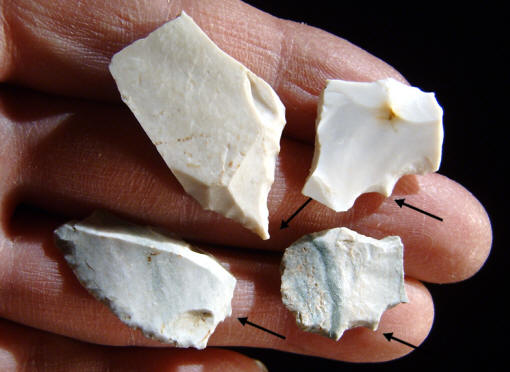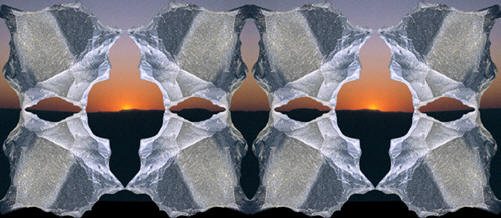|
"Graver: Strictly
speaking, a flake or blade with a small, sharp projection that has been
created by unifacial retouch. The term is often loosely applied to a
broad range of flake artifacts with spurs."---1990,
Richard Michael Gramly, "Guide To The Paleo-Indian Artifacts Of
North America," p. 26.
"Gravers, another minority type, are
specifically assigned to bone working, although they are too delicate to
have performed major functions. Tests on fresh antler and bone show
that, though they serve to incise small lines and grooves, they are
easily worn down under extensive use."---1985,
George F. MacDonald, "Debert, A Paleo-Indian Site In Central Nova
Scotia," p. 113.
"---an
"inferred Clovis lithic tool kit" would contain: (1) bifacial, fluted
projectile points, (2) large bifaces used as tools and also as point
preforms, (3) blades and blade cores, (4) cutting and scraping tools
made on blades and flakes, (5) gravers, and (6) a variety of
end-scrapers."---2002,
Gary Haynes, "The Early Settlement Of North America, The Clovis Era," p. 111.
"Perforators:
These tools, also referred to in the literature as awls, gravers and
drills, have a distinctive point or spur, usually formed through one or
two converging concave edges."---1991, Ted
Goebel, Roger Powers, and Nancy Bigelow, "The Nenana Complex Of
Alaska And Clovis Origins," pp. 219-220.
"Single and
double-spurred gravers are relatively common components of the Dalton
tool-kit - as they are of much older Paleo-American flaked stone
assemblages. Spurs are usually sited at the narrow end of long flakes or
at the corners of polygonal flakes"---2008,
Richard Michael Gramly, "Return To Olive Branch: Excavations
2002-2005" p. 110.

GRAVERS
ILLUSTRATED GRAVERS ARE FROM BOSTROM, MESA,
MARTENS, OLIVE BRANCH, PHIL STRATTON
& SUGARLOAF SITES
NORTH AMERICA
PALEO-INDIAN,
ARCHAIC, WOODLAND &
MISSISSIPPIAN
EST. 14,000
YEARS AGO TO EUROPEAN CONTACT
Gravers are simple
unifacial stone tools. In one form or another they have been used by different cultures
around the world for tens of thousands of years. In North America, gravers have been
found on Paleo-Indian, Archaic, Woodland and Mississippian sites. Paleo
and Archaic sites have produced the highest percentages of gravers.
|
|
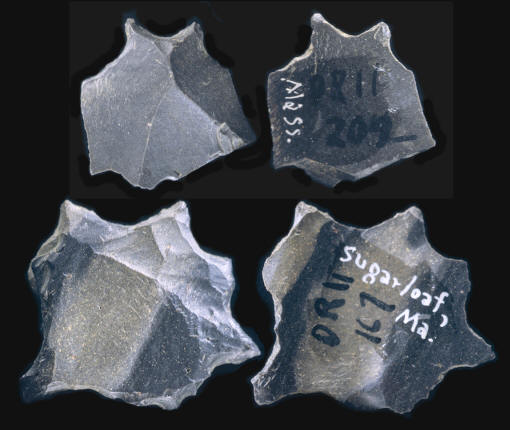
MULTI-SPURRED GRAVERS
SUGARLOAF SITE
FRANKLIN
COUNTY, MASSACHUSETTS
CLOVIS CULTURE
PRIVATE
COLLECTION
These two multi-spurred gravers were found of the Sugarloaf Clovis
site in Franklin County, Massachusetts. Most gravers only have one
point or spur. A smaller percentage has two points. The lower
example in this picture appears to have as many as five spurs. |
|
|
By definition,
gravers are unifacial tools that are made on simple flakes. They were
made from blades produced from prepared cores and from simple randomly produced percussion
flakes. Flake preforms selected for graver manufacture display no
obvious consistency. Most gravers were made by pressure flaking one
side only. |
|
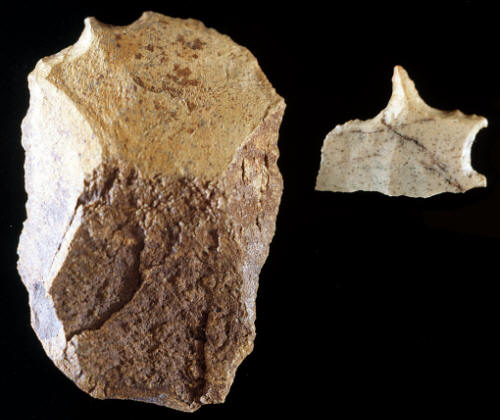
SINGLE & MULTI-SPURRED GRAVERS
MESA SITE
NORTHERN ALASKA
ARCTIC CIRCLE
PALEO-INDIAN
HUNTING LOOKOUT
BUREAU OF LAND MANAGEMENT
Both of these gravers were discovered during the excavation of the
mesa site in northern Alaska. They date to approximately 10,400
years ago. The multi-spurred graver on the right is very small. It
measures 9/16 inch (1.4 cm) long. It appears to have three graver
spurs that are located on two of the sides of the flake. |
|
|
The location of the
working edge of a graver is referred to, in various reports, as bits,
points, projections and spurs. These can be categorized in either one of
two basic types. One type has acute, below 60 degrees, angled edges and
the other has much steeper, above 60 degrees, angled edges. The steeper
angle produces a more delicate working edge. |
|
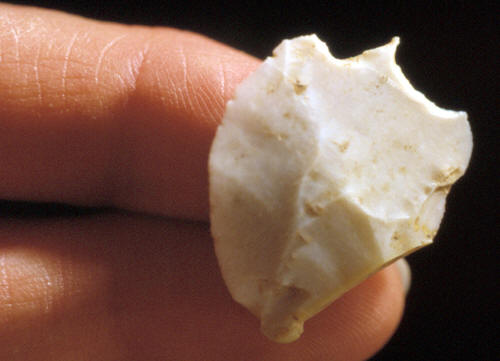
SINGLE SPURRED GRAVER
MARTENS SITE
ST. LOUIS
COUNTY, MISSOURI
EARLY PALEO-INDIAN HABITATION
SITE
PRIVATE
COLLECTION
This very delicate single spurred graver was found on the Martens
Clovis site in St. Louis County, Missouri. The spur was formed by
pressure flaking two notches close together which isolated a
projection in the center. This tool would have been used to cut or
perforate soft materials such as wet hide or fish. |
|
|
The edge angle of graver bits probably reflects functional differences.
The more acutely angled points are sturdier and would stand up to
heavier use. The more steeply angled points would have been used for
more delicate jobs, such as piercing the eye of a needle. |
|
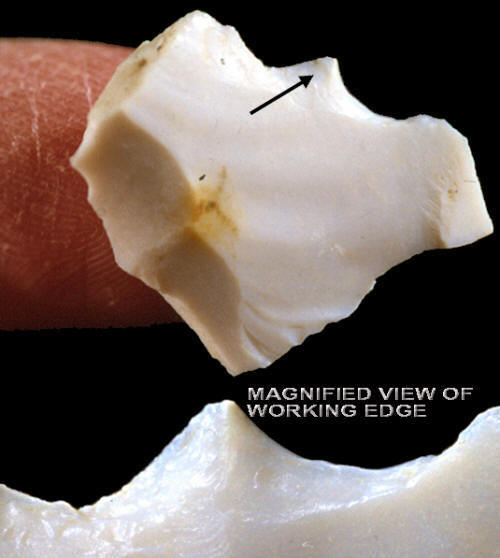
SINGLE SPURRED GRAVER
BOSTROM SITE
ST. CLAIR
COUNTY, ILLINOIS
PALEO-INDIAN
HABITATION SITE
PRIVATE
COLLECTION
This graver
was found several years ago in St. Clair County, Illinois. It was found sometime in the late 1970's by
either Bob or Pete Bostrom while surface collecting on the
Bostrom
Clovis camp site.
This graver was made on a simple flake. The single point or spur was formed by pressure flaking two shallow notches along one edge. This
graver is made of good quality Burlington
chert. It measures 1 1/16 inches (2.6 cm) long, 13/16 inch (2.1 cm) wide
and 3/16 inch (5 mm) thick.
|
|
|
Use wear analysis of the working edges of gravers have shown
they were used to cut, drill or perforate several different types of
materials. Tom Tomenchuk describes use wear evidence on several
different graver points from the Fisher Paleo-Indian site in southern
Ontario. He
reports that gravers were used on various types of organic materials,
such as: soft animal tissue like fish, hides, hard surfaces such as
antler and seasoned wood, bone and softer woods. He also found evidence
that some gravers were probably hafted and used as drills. |
|
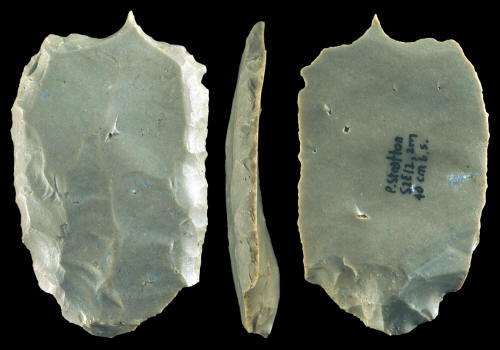
SINGLE SPURRED GRAVER
PHIL
STRATTON SITE
LOGAN
COUNTY, KENTUCKY
CUMBERLAND
HABITATION SITE
PRIVATE
COLLECTION
This combination graver and side-scraper was found during
the excavation
of the Phil Stratton site in 2005. The bulb of percussion, where the
blade was struck from the core, is still evident on the end even though
it has been partially trimmed away by pressure flaking. This graver
/ side-scraper is made of St. Genevieve chert and it measures 2 1/4
inches (5.7 cm) long. By Michael Richard
Gramly
This finely crafted combination side-scraper and graver, made of St.
Genevieve chert, was excavated from the Phil Stratton site in Logan
County, southwestern Kentucky (Gramly 2005). The Phil Stratton site is a
closed or single-component encampment of the Cumberland archaeological
culture. Completed fluted projectile points, point preforms, a variety
of scrapers and utilized flakes – most made on prismatic blades –
are among the 200 flaked tools recovered to date (7-22-05). |
|
|
Edge wear analysis has shown that the tips of graver points
can be polished or striated from use. The Bull Brook site produced
striated examples that indicated the striae orientation direction of use
along the same axis as the spur or point. Some gravers from the Fisher
site are described as having been used in a twisting motion, "Intense
rounding of all edges accompanies a bright polish along the edges of the
ventral surface and along the right side of the dorsal ridge. Together
with intensive microchip scarring of the right edge of the ventral
surface, the wear pattern suggests that the tool was used with a
dominant clockwise torque (Tomenchuk, 1997)." |
|
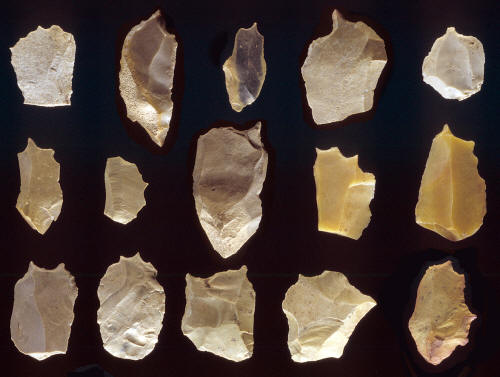
SINGLE & DOUBLE SPURRED GRAVERS
OLIVE
BRANCH SITE
ALEXANDER
COUNTY, ILLINOIS
EARLY ARCHAIC
DALTON HABITATION SITE
PRIVATE
COLLECTION
These fifteen single and double spurred end scrappers were
discovered during the excavation of the Olive Branch site in
southern Illinois. These gravers were made and used by Early Archaic
Dalton people approximately 11,000 years ago. About half of them
have two spurs or points. Most, but not all of the spurs are located
on the ends of the flakes. Some have spurs on a side of the flake.
Two of the cherts are identified as Kaolin and Cobden/Dongola.
The Kaolin graver to the right in the second row measures 4.8 cm
long. |
|
|
Most gravers have one working edge in the form of a single
spur or bit. A smaller number of gravers are double spurred and have two
cutting or drilling points. There are also multi-spurred gravers with three or more points or bits. One example
from the Bull Brook Paleo-Indian site in Massachusetts is reported to
have five points. Another example from the Sugarloaf site, illustrated
in this report, also has five points or spurs.
Gravers are one of the simplest forms of stone tools. They
most certainly evolved long ago from a sharp corner of an unmodified
flake. Gravers may even have been reinvented through time in different
regions of the world as humans evolved into more advanced cultures.
After all the analysis and descriptions are said and done they are most
impressive for their simplicity and versatility. |
|
"REFERENCES"
1984,
Grimes, John R., Eldridge, William, Grimes, Beth G., Vaccaro,
Antonio, Vaccaro, Frank, Vaccaro, Joseph, Vaccaro, Nicolas, Orsini,
Antonio, "Bull Brook II," Archaeology Of Eastern North America,
p. 165.
1985,
MacDonald, George F., "Debert, A Paleo-Indian Site In Central
Nova Scotia," p. 113.
1990, Gramly, Richard Michael, "Guide To The Paleo-Indian
Artifacts Of North America," p. 26.
1991, Goebel, Ted, Powers,
Roger, and Bigelow, Nancy, "The Nenana Complex Of Alaska And Clovis
Origins," pp. 219-220.
1996, Lewis, Barry, "Kentucky Archaeology," Mississippian
Farmers, p.129.
1997, Storck, Peter L., "The Fisher Site, Archaeological,
Geological and Paleobotanical Studies At An Early Paleo-Indian Site In
Southern Ontario, Canada," p. 83.
2002,
Haynes, Gary, "The Early Settlement Of North America, The Clovis
Era," p. 111.
2008, Gramly, Richard Michael, "Return To Olive Branch:
Excavations 2002-2005" p. 110.
|
|
RECENT
LISTINGS HOME
ORDERING |
